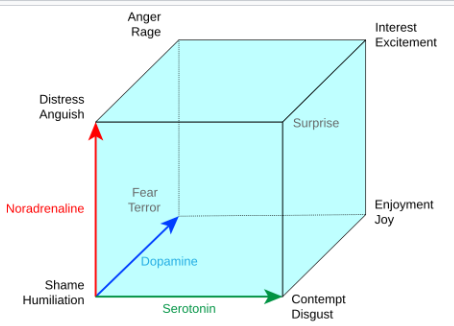Quiz 4: Chemistry of Emotion
1/14
There's no tags or description
Looks like no tags are added yet.
Name | Mastery | Learn | Test | Matching | Spaced |
|---|
No study sessions yet.
15 Terms
Receptor Action (0.5 pts each)
Neurotransmitters bind to the postsynaptic cell, causing an effect.
Release
Vesicles empty the neurotransmitter into the synapse.
Synthesis
Neurotransmitters are derived from DNA or food.
Inactivation
Neurotransmitter is removed from the synapse to stop causing an effect.
Neurotransmitters can have two effects on their targets. … effects make the target neuron more likely to fire an action potential; … effects make the target neuron less likely to fire an action potential.
a. Excitatory; Inhibitory b. Inhibitory; Excitatory c. Chemical; Electrical d. Electrical; Chemical
A 26-year-old male presents with substance use disorder and pathological gambling. The neurotransmitter system most likely involved with those disorders is
a. acetylcholine b. dopamine c. norepinephrine d. serotonin
Acetylcholine
Involved in muscle activation, attention, learning, and memory. (Ex. Alzheimer’s, myasthenia gravis)
*Dopamine*
Involved in reward, motivation, movement, and learning. (Ex. Parkinson’s, Schizophrenia, addiction)
Norepinephrine
Involved in arousal, alertness, stress response, and attention. (Ex. ADHD, depression, anxiety)
Serotonin
Involved in mood regulation, sleep, appetite, and emotion. (Ex. Depression, anxiety, OCD)
Any given pharmaceutical treatment of a mood disorder does not relieve symptoms for 100% of patients (ex. SSRIs like Zoloft aren’t effective for everyone who has depression). Use what you know about neurotransmitter systems to explain why there is often trial and error in finding the right medication to treat mood disorders. (1pt)
There is often trial and error in finding the right medication to treat mood disorders because everyone has different brain chemistry. One person could be experiencing abnormalities with their serotonin system while one is experiencing abnormalities with their norepinephrine system. Since medications target specific systems, the same drug may work well for one person but not the other. Medications also affect everyone in different ways so it takes time to find the most effective one.
Identify the monoamine neurotransmitters included in the model proposed by Lovheim. Explain how a small number of neurotransmitters can give rise to at least eight different emotions (you may use specific emotions to illustrate your explanation if you like; there is more room for your answer on the next page.) (3pts)
Monoamine neurotransmitters are serotonin, dopamine, and norepinephrine.
You can get at least eight different emotions from a small number of neurotransmitters because of the combinations of the neurotransmitter levels. There are different levels of each, from high to low, and combining them in different ways creates different emotions according to Lovheim. He visualized this with a cube where the eight emotions are on the corners, and they each have a high and low intensity version. For example, anger/rage has high levels of dopamine and serotonin and low levels of norepinephrine.(Draw cube with anger in top left)

You decide to replicate Salimpoor et al.’s study using clips from each participant’s favorite comedy movie (for the purposes of this question, assume this manipulation will evoke pleasurable feelings).
a. If you successfully replicate their study, which brain region in the reward system do you expect will be more active during anticipation of the video clip? (1pt)
Caudate Nucleus
b. Also assuming successful replication, which brain region in the reward system do you expect will be more active during peak emotional experience of the video clip? (1pt)
NAcc (Nucleus accumbens)
c. Do you think that the number of chills and intensity of those chills is a reliable and valid physiological marker of autonomic nervous system arousal, as the authors of the original study suggested? Why or why not? (1pt)
I don’t think it is the most reliable measure because a person can get chills for various other reasons that just arousal. Chills are very individual and subjective thing so it seems hard to get them to be fully reliable and valid. It might also be hard to replicate the intensity of someone’s chills in relation to emotional arousal from music. Using other measures alongside chills like heartrate or fMRI could make it a more reliable measure.